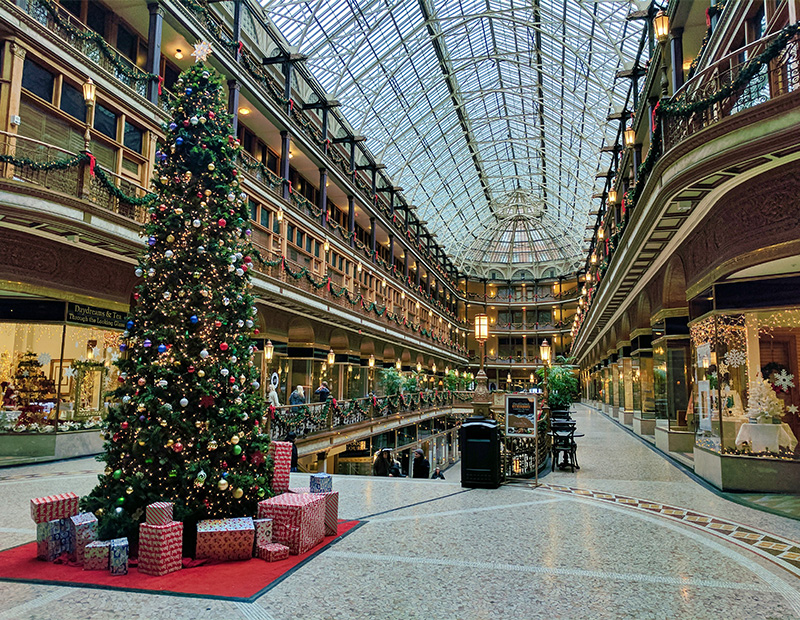Top Trends for the 2019 Holiday Retail Season
CBRE takes a look at four trends impacting the last holiday season of the decade including pop-up shops, the rise of resale and delivery challenges.
With a late Thanksgiving this year the holiday shopping season is the shortest since 2013, putting pressure on retailers and shippers to get merchandise to stores and homes faster than ever as consumers increasingly expect same-day, next-day and free delivery.
READ ALSO: Q&A: The Key to Competitive Financing for Retail
The compressed shopping season led many stores to begin promotions long before Black Friday, including Walmart which launched its holiday sales on Oct. 25, according to the CBRE annual Holiday Retail Trends Guide. The tight shopping season and heated delivery competition among shippers like UPS and FedEx are among the top four trends CBRE is highlighting this year. Also topping the trends list for the last holiday season of this decade are the increasing proliferation of pop-up stores and growing popularity of resale goods as gifts.
Meghann Martindale, CBRE global head of retail research, said in a prepared statement that shoppers will be the winners this year, as retailers strive to serve them where, when and how they want. Advancements in delivery, pop-up retail and resale are among the ways that will be on full display this holiday season.
Anthony Buono, CBRE global president, retail, agreed. He noted in prepared remarks that shoppers have more options than ever before whether shopping in stores, online, or increasingly, a combination of both.
The CBRE report predicted retail sales would be growing across brick-and-mortar, online and mobile channels and this weekend’s activity, including on Black Friday, seem to bear that out. U.S. shoppers spent more than $4.2 billion online on Thanksgiving Day and $7.4 billion online on Black Friday, according to Adobe Analytics. Friday was also a record day for mobile sales, hitting $2.9 billion. But brick-and-mortar stores weren’t left out of the shopping action with a 4.2 percent increase on Black Friday compared to normal shopping activity, according to Fiserv. The online shopping is expected to peak today, Dec. 2, with Cyber Monday online sales expected to hit $9.4 billion. For those who combine online and brick-and-mortar shopping, buy-online/pick-up-in-store (BOPS) was up 43.2 percent this year, signaling retailers are connecting their multi-channel operations, according to Adobe.
Results from the first big holiday shopping weekend are a good indication that the retail sector may see the average 4 percent increase that the National Retail Federation is projecting for 2019. Martindale noted that the solid U.S. economy and strong jobs market should help lead to a healthy holiday retail season. On Sunday, Martindale said in a prepared statement that the Black Friday weekend shopper traffic was better than last year at most malls and shopping centers managed by CBRE. She said shoppers seemed to be responding to retailers’ discounts and promotions, as well as to the efforts made by many centers to position themselves as dining and entertainment destinations, not only shopping venues.
More Pop-Ups
One of the strategies increasingly being used at retail centers is multiple pop-up stores to generate customer traffic, introduce new merchandise and test new concepts. Among the high-profile pop-ups this season are Tiffany & Co. launching a men’s lifestyle collection in a 200-square-foot pop-up at The Grove in Los Angeles and lifestyle brand Goop opening a pop-up in Chicago’s River North neighborhood. Toys R Us, which is emerging from bankruptcy as Tru Kids, is opening two pop-ups with Candytopia in Chicago and Atlanta that range from 30,000 to 36,000 square feet. It also relaunched its e-commerce platform in partnership with Target.
Resale market booming
CBRE finds the resale market is booming as price-sensitive Millennials and Gen Zers look to recycling and upcycling their fashions. The stigma for second-hand clothing is shifting as consumers focus on extending the life of garments and reducing environmental impacts. An Accenture study found 48 percent of consumers said they would buy pre-used apparel and accessories as gifts and 56 percent said they would welcome second-hand gifts. Resale and apparel rental companies, both on-line and brick-and-mortar, are offering discounts up to 90 percent to capture fashionistas looking for second-hand options. CBRE noted The Real Real, a leading online luxury reseller which is entering the brick-and-mortar market, offers a buy-now/pay-later (BNPL) payment option with partner Affirm that has short-term, flexible-payment installment programs for big-ticket purchases that could become a more common payment platform in the year ahead.
Delivery options abound
The compressed shopping season and growing importance of BOPS means the shipping deadlines this year are tighter than ever too. Retailers are increasing their seasonal workforce dedicated to fulfillment and delivery and FedEx and UPS are aligning with retailers to make the delivery and return process as easy as possible for consumers, according to the CBRE report. Target is adding 8,000 seasonal workers to its distribution and fulfillment centers, up from 7,500 last year. It is also doubling in-store seasonal employees mainly to focus on fulfilling e-commerce orders.
Amazon is offering free one-day delivery and free returns for Prime members in more than 1,500 Kohl’s locations. UPS, which is hiring 100,000 seasonal workers this year, is expanding its retail partnerships. This year its UPS Access Points program will be in 1,100 Michael’s stores as well as in CVS and Auto Zone locations allowing consumers to ship to and pick up from store locations. FedEx, which is hiring 50,000 seasonal employees, is expanding its partnership with Walgreens this year to provide shipping and return services in 7,300 locations and also offering the service at 8,000 Dollar General stores.








You must be logged in to post a comment.